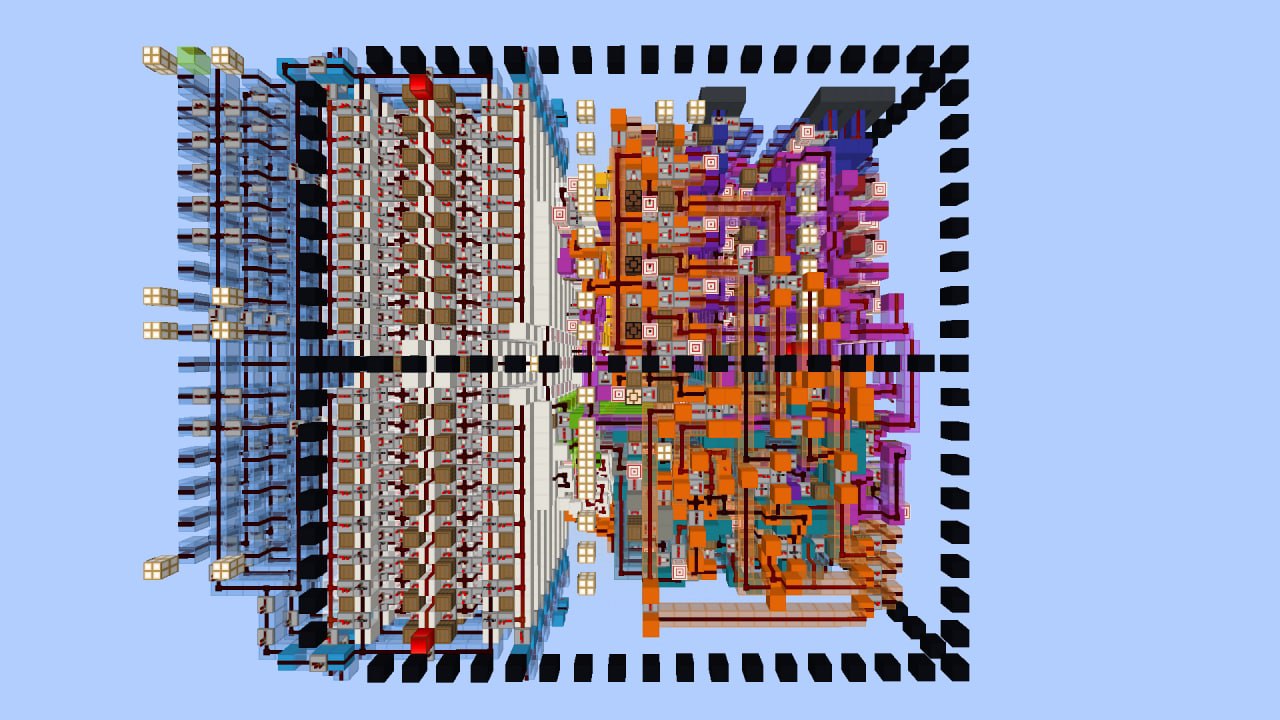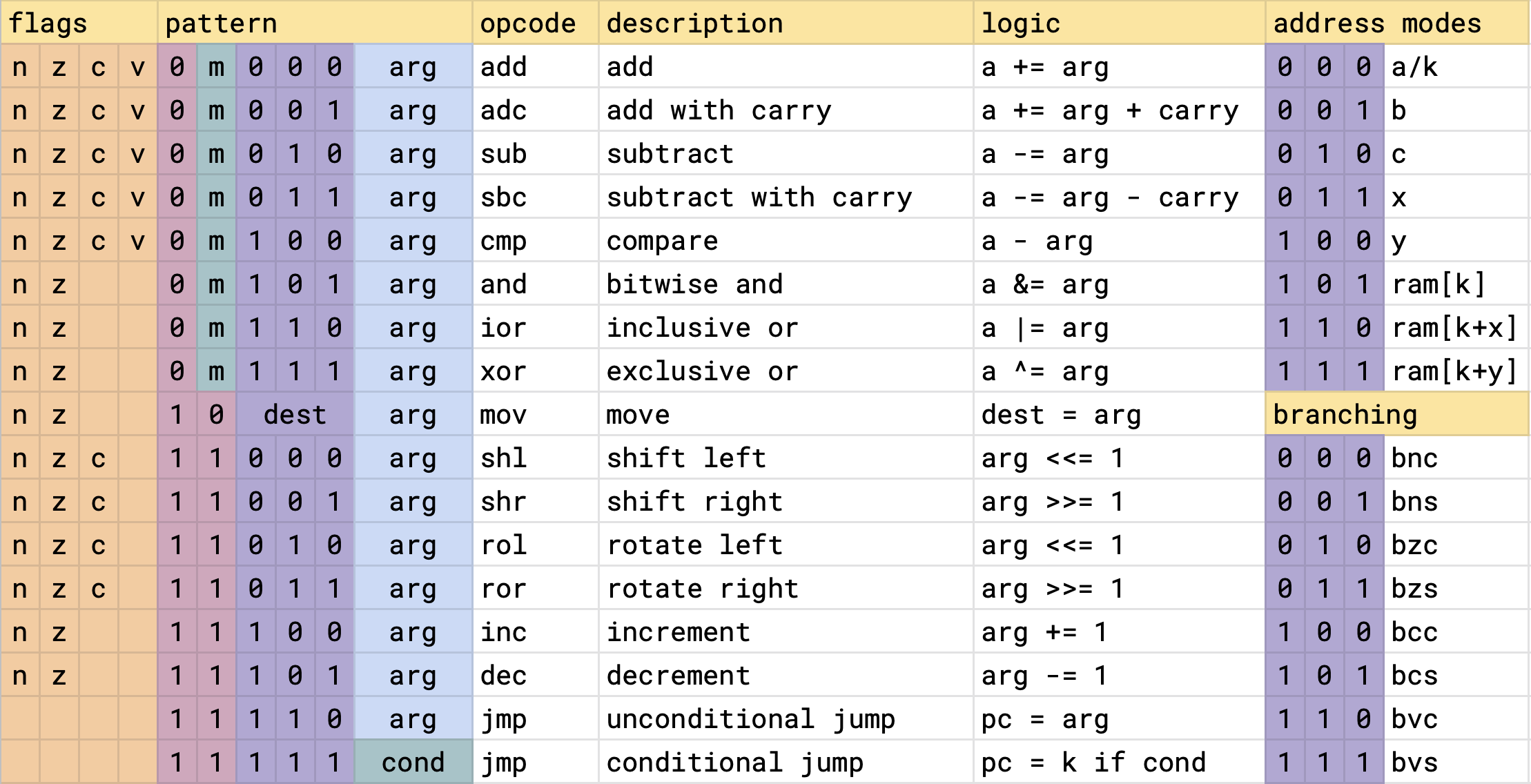Mira
Written September 15, 2021
Mira is an 8-bit CPU architecture designed to have an efficient implementation in Minecraft completed in September 2021.

Instruction set
The instruction set architecture (ISA) for the CPU takes inspiration from the 6502 and 8008 microprocessors. The CPU has an accumulator and could be classified as CISC with its variable length instructions and ability to use memory directly as an argument. The feature-rich and orthogonal ISA makes it a joy to write programs for. It features:
- 16 instructions
- Five registers: an accumulator (A) and four general-purpose registers (B, C, X, Y)
- Four condition flags: carry, zero, overflow, and sign
- Five addressing modes: immediate, memory, indexed-memory, registers, and accumulator
- 8-bit variable-length instructions (taking 1-3 bytes)
- 8-bit address space (can use Harvard or Von-Neumann layout, and bank switching to increase it)
- Memory-mapped I/O

This is the canonical bit-encoding for the ISA. An implementation is free to shift instructions and bits around to decode it more efficiently, as was done for Minecraft. An implementation is considered valid as long as any assembly program can be executed on it.
Flags
On the left, we have the four processor flags. The presence of a letter in a column indicates whether the instruction updates this flag. The flags can not be written to or read from directly. They are modified as a side effect of other instructions, or read when performing conditional branching.
Negative: Set if bit 7 of the result is setZero: Set if the result was zeroCarry: Set if the arithmetic operation produced a carry or borrow. It also holds bits after a shift.oVerflow: Set if the addition of two like-signed numbers or the subtraction of two unlike-signed numbers produces a result greater than +127 or less than -128.
Addressing modes
Shifting our attention to the top-right, we have the addressing modes. All instructions with an arg field can use one of the addressing modes in this list. Whether 000 refers to the A register or an immediate (K) depends on the "instruction group" (explained in following section).
Mira has 5 registers - A, B, C, X, and Y. Register A (accumulator) functions implicitly as an operand and destination in "Group 0" instructions. B, C, X, and Y serve as general-purpose registers. X and Y can also function as index registers during indexed memory addressing.
Mira lacks a program counter since all jumps use direct addressing which eliminates the need to compute offsets. Function call return addresses are stored as constants and pushed to the stack manually
Instruction groups
The first two bits of the opcode decode the four instruction groups.
Group 0: Two-operand arithmetic and logical operations. arg==000 is a NOP instruction.
Group 1: Same as group 0, but the arg "becomes the accumulator", and the operation is performed with an immediate (a constant stored in the next byte of the program). arg==000 is the A register.
Group 2: A move instruction that moves the arg to a dest. dest/arg==0 is the A register. If dest==arg, then arg is an immediate. This also supports moving an immediate to memory. Memory to memory moves are not supported by any implementation, but there's nothing intrinsic that would prevent them.
Group 3: Single argument arithmetic and logical operations. arg==0 is the A register. Shoehorned into this group are the conditional and unconditional jump instructions. For unconditional jumps, arg==0 is an immediate. Conditional jumps use the conditions in the bottom-right branching table. For example, to branch if the carry flag is set, use bcs, for branch if carry clear, use bcc. The same goes for the other flags n,z,v.
Minecraft implementation details
The Minecraft implementation features:
- 2Hz clock (5 redstone ticks per cycle)
- 4-stage pipeline
- 32 byte instruction cache
- No data hazards
- One cycle branch penalty
- Executes one instruction byte per cycle
- No program counter: A shift register is built into the instruction cache for advancing the IP
- Harvard memory layout
It also incorporates techniques to reduce the number of updates it causes during program execution, including:
- No clock: The CPU is perfectly synchronized and uses a "Waterfall" pipeline design
- Minimal redstone to reduce game updates
- Directly decoded control lines instead of using a PLA
- Pre-powered bussing lines
ISA rationale
Why no SEC/CLC instructions like the 6502?
The 6502 couldn't inc/dec the accumulator, and it didn't have add/sub without carry instructions. Having these instructions makes SEC/CLC unneeded.
Why don't INC and DEC update carry flag?
- Preserves the carry flag across iterations in loops
- The N and Z flags can detect rollovers
- x86 does it the same way
Why no dedicated call/subroutine instructions?
- It is difficult to perform this instruction in 1 cycle which Would violate the 1 cycle per byte objective
- The data path for these instructions is complicated, they require post/pre increment/decrement support on a stack pointer
- Don't want to waste a full register on a stack pointer
- User can decide what calling convention is most efficient
- They can memory-map a stack, allowing for a call in 5 cycles and a return in 2 cycles
Why no fancy hardware, such as stack, barrel-shifter, multiplier, etc.?
- Complex hardware optimizes for specific instead of general-purpose workloads
- Increases the size of the CPU
- Data paths become more complicated, likely not possible under the current speed constraints
- Trivial to memory-map, which is a much more flexible approach
Why not use port-mapped I/O?
- Data must move through the accumulator instead of a register directly
- Memory-mapped allows you to use different addressing modes
- Similar to more complex hardware, we want to avoid implementing hardware that some workloads may not need.
Why an accumulator architecture as opposed to a 3-op load-store?
- Smaller program sizes due to denser instruction set
- Simpler and speedier data loop due to accumulator
- Requires fewer components, lack of dual read registers, register decoders
- A load-store variant would require a 16-bit ISA, increasing instruction cache pressure
Memory-mapped I/O
Memory-mapped devices are a great way to extend the functionality of the CPU. A device just has to define some interface of reading and writing to designated addresses. Here are some examples:
8x16 TTY Screen
[screen]: read char at cursor, write char to cursor
[flags]: auto-increment, clear, character-set, etc.
[cursor]: the index location of where to write to
7-bit value for location of character, rrrcccc
Ticker tape: for printing streams of decimal values
[ticker]: write a value
Keyboard:
[keyboard]: works as a queue of characters
[flags]: blocking/non-blocking read
Multiplier 8x8=16
[multiplicand]: Write multiplicand, read lower byte of product
[multiplier]: Write multiplier, read upper byte of product
Divider 8/8=(8,8)
[dividend]: Write dividend, read quotient
[divisor]: Write divisor, read remainder
Assembler
I wrote an assembler in Rust.
Assembler directives
.str "hello"
.strz "hello" ; null-terminated string
.u8 5 ; define 8 bit integer
.i16 32 ; define a signed 16-bit integer
.u8 32, 26 ; define a list of unsigned 32-bit integers
Addressing modes
jmp $0x01 ; jump to the address stored at memory address 0x01
jmp 0x01 ; jump to the address 0x01
jmp label ; jump to label or ram address
jmp B ; jump to the value stored in register B
add $0x05 ; add the value stored at memory address 0x05
add 0x05 ; add the value 0x05
add A, arr[1] ; add the value at memory[arr+1] to A
Example programs
; Countdown program
; Print A..=0 to the TICKER device
; input a: the starting count
mov a, 10 ; move the decimal constant 10 to A
loop: mov TICKER, a ; write value in A to the ticker device
dec a ; decrement the value in A, updating the flags
bnc loop ; Branch to label "loop" while A is not negative
; Array sum
; input: x = length of the array minus 1
; result: sum in A
arr: .i8 1, 0, 2, 5, -2, 4
mov x, 5 ; store length of array minus 1 in X
loop: add arr[x] ; add the value at memory address [arr+x]
dec x ; decrement X register
bnc loop ; while x >= 0, goto loop
; Count set bits (popcnt) (5 bytes)
; input: B, C=0
; result: A
loop: adc c ; add the carry flag to the accumulator
start: shr b ; shift LSB into carry flag
bne loop ; loop while b != 0
adc c ; dont forget final bit
; 8x8=8 multipy (7 bytes)
; multiplicant in b
; multiplier in c
; output in a
do_add: add b
loop: shl b
start: shr c ; is multiplier odd?
bcs do_add ; add the multiplicand
bne loop ; else loop while bits remaining in multiplier
; Collatz conjecture (14 bytes)
; starting value in A
loop: mov TICKER, a ; print value
shr a ; divide by 2
bzs end ; if we hit 0 we're done
bcc loop ; loop while even
rol a ; restore true odd value
mov b, a ; compute a = 3a+1
shl a
add b
inc a ; a = 3a+1 at this point
jmp loop
end:
; u8 insertion sort
arr: .u8 8, 6, 4, 10, 36, 23, 48, 12, 42, 5
mov c, 9 ; length of array minus one
outer: mov b, arr[x+1]
mov y, x
inner: mov a, arr[y]
cmp b
bcc next
mov arr[y+1], a
dec y
bpl inner
next: mov arr[y+1], b
inc x
dec c
bne outer
Calling convention
The calling convention isn't strict and up to the user. My preference is for the stack to grow downward with post-decrement for push. Here's an example implementation of that
- post-decrement stack for push
- pre-increment for pop
- PC pushed first, then function args in reverse order
; def my_func(a, b):
; return a - b
my_func:
mov a, [sp+1] ; access 1st arg
sub [sp+2] ; access 2nd arg
; despite being accumulator, we can add imm constants
; to registers, handy for collapsing stack frame
add sp, 3 ; num args + 1 for pc
jmp [sp] ; return
; my_func(3, 5)
; push the program counter
mov [sp], PC
dec sp
; push args in reverse order
mov [sp], 5 ; can push imm/reg directly
dec sp
mov [sp], 3
dec sp
jmp my_func ; call